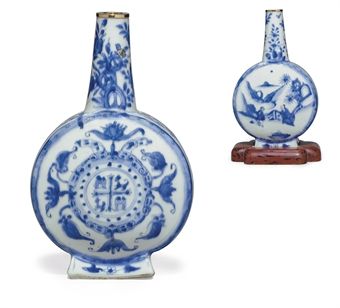A Rare and Early Blue And White Armorial Bottle, circa 1610-20
A Rare and Early Blue And White Armorial Bottle, circa 1610-20
Formed as a pilgrim flask, the circular, drum-form body below a slender, tapering neck and supported on a short, splayed foot, on the front the arms of Philip II of Spain and Portugal within a frame of scrolls issuing tulip-like blooms, the edge a blue dotted band, the sides painted with lotus scroll and the neck with flowering plants growing from rocks, and on the back a garden scene showing a boy servant approaching a seated scholar, the rim with gold mount stamped 20K, together with a later Japanese red lacquered fitted wood stand. 10 in. (25.4 cm.) high (2). Estimate 60,000 - $80,000
Notes: As depicted these arms were borne by Philip II of Spain (1556-98), ruler of Portugal 1580-98. But as several modern writers have shown, the arms do not reflect a commission of the King, but rather were based on a Spanish coin, one of the ocho reales, or pieces of eight, that had become the world's trading currency by the late 16th century. Spanish mines in the New World provided the silver, and mints in South and North America struck these coins, the first in Lima in 1570. A. Diez de Rivera suggests that the source for the bottle arms may have been a coin minted in Mexico in 1588 (Oriental Art, vol. XLV, no. 1, 1999, p. 39.)
M.K. Gristina points out that the bottles known with this decoration fall into two groups, one with floral decoration and the other with the scholar scene, as in the present example. L.C. de Matos notes that likely the group was intended for some institution dependent on Spanish royal power. (See Portugal in Porcelain from China, A.V. Santos, ed., Lisbon, 2007, pp. 179-185.) Curiously a number of these flasks have been discovered in Japan. It seems that the bottles, having been made in the heyday of Spain's presence in Macao from 1580 to 1640, were somehow taken to Japan once the Spanish abandoned their outpost, where some remained for more than 400 years.
Santos et al illustrate a similar bottle with gilt-metal mount in the collection of the Gonçalves Museum, Lisbon, and another, with silver mount, from the Carmona e Costa Foundation, Lisbon (op. cit., pp. 185 and 184.) Other examples were sold Christie's, London, The Peony Pavilion collection, 12 June 1989, lot 401, and Christie's, London, 12 November 2002 and 14 June 2001 (also cut-down.)
Christie's. Chinese Export Porcelain. 21 January 2009. New York, Rockefeller Plaza. Image 2009 Christie's Ltd. www.christies.com

/https%3A%2F%2Fprofilepics.canalblog.com%2Fprofilepics%2F1%2F0%2F100183.jpg)
/https%3A%2F%2Fstorage.canalblog.com%2F03%2F02%2F119589%2F96711876_o.jpg)
/https%3A%2F%2Fstorage.canalblog.com%2F11%2F31%2F119589%2F94773502_o.jpg)
/https%3A%2F%2Fstorage.canalblog.com%2F20%2F83%2F119589%2F94772815_o.jpg)
/https%3A%2F%2Fstorage.canalblog.com%2F26%2F72%2F119589%2F75604929_o.jpg)
/https%3A%2F%2Fstorage.canalblog.com%2F59%2F60%2F119589%2F26458628_o.jpg)



/image%2F1371349%2F20240416%2Fob_2a8420_437713933-1652609748842371-16764302136.jpg)
/image%2F1371349%2F20240414%2Fob_83ee65_2024-nyr-22642-0954-000-a-blue-and-whi.jpg)
/image%2F1371349%2F20240414%2Fob_15808c_2024-nyr-22642-0953-000-a-blue-and-whi.jpg)
/image%2F1371349%2F20240414%2Fob_e54295_2024-nyr-22642-0952-000-a-rare-blue-an.jpg)